Aircraft carrier
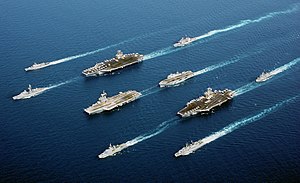
Anaircraft carrieris awarshipthat serves as a seagoingairbase,equipped with a full-lengthflight deckand facilities forcarrying, arming, deploying, and recovering aircraft.[1]Typically, it is thecapital shipof a fleet, as it allows a naval force toprojectair powerworldwide without depending onlocal bases for staging aircraft operations.Carriers have evolved since their inception in the early twentieth century from wooden vessels used to deployballoonstonuclear-poweredwarships that carry numerousfighters,strike aircraft,helicopters,and other types of aircraft. While heavier aircraft such as fixed-winggunshipsandbombershave been launched from aircraft carriers, these aircraft have not landed on a carrier. By its diplomatic and tactical power, its mobility, its autonomy and the variety of its means, the aircraft carrier is often the centerpiece of modern combat fleets. Tactically or even strategically, it replaced thebattleshipin the role of flagship of a fleet. One of its great advantages is that, by sailing ininternational waters,it does not interfere with any territorial sovereignty and thus obviates the need for overflight authorizations from third-party countries, reduces the times and transit distances of aircraft and therefore significantly increases the time of availability on the combat zone.
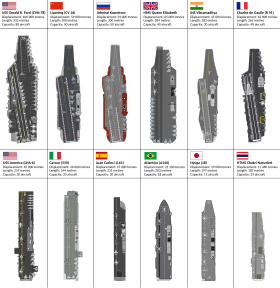
There is no single definition of an "aircraft carrier",[citation needed]and modern navies use several variants of the type. These variants are sometimes categorized as sub-types of aircraft carriers,[2]and sometimes as distinct types ofnaval aviation-capable ships.[3]Aircraft carriers may be classified according to the type of aircraft they carry and their operational assignments.AdmiralSirMark Stanhope,RN, formerFirst Sea Lord (head)of theRoyal Navy,has said, "To put it simply, countries that aspire to strategic international influence have aircraft carriers."[4]Henry Kissinger,whileUnited States Secretary of State,also said: "An aircraft carrier is 100,000 tons of diplomacy."[5]

As of July 2024, there are 47 active aircraft carriers in the world operated by fourteen navies. TheUnited States Navyhas 11 large nuclear-poweredfleet carriers—carrying around 80 fighters each—the largest carriers in the world; the total combined deck space is over twice that of all other nations combined.[6]As well as the aircraft carrier fleet, the US Navy has nineamphibious assault shipsused primarily for helicopters, although these also each carry up to 20 vertical or short take-off and landing (V/STOL) fighter jets and are similar in size to medium-sized fleet carriers. India, the United Kingdom and China each operate two aircraft carriers. France and Russia each operate a single aircraft carrier with a capacity of 30 to 60 fighters. Italy operates two light V/STOL carriers and Spain operates one V/STOL aircraft-carrying assault ship.Helicopter carriersare operated by Japan (4, two of which are being converted to operate V/STOL fighters),France(3),Australia(2),Egypt(2), South Korea (2), China (3), Thailand (1) and Brazil (1). Future aircraft carriers are under construction or in planning by China, France, India, Russia, South Korea, Turkey, and the US.
Types of carriers
[edit]
General features
[edit]- Speed is a crucial attribute for aircraft carriers, as they need to be able to be deployed quickly anywhere in the world and have to be fast enough to evade detection and targeting from enemy forces. A high speed also increases the "wind over the deck", boosting the lift available for fixed-wing aircraft to carry fuel and ammunition. In order to evade nuclear submarines, the carriers should have a speed of more than 30 knots (35 mph; 56 km/h).
- Aircraft carriers are among the largest types of warships due to their need for ample deck space.
- An aircraft carrier must be able to perform increasingly diverse mission sets. Diplomacy, power projection, quick crisis response force, land attack from the sea, sea base for helicopter and amphibious assault forces, anti-surface warfare (ASUW), defensive counter air (DCA), andhumanitarian aiddisaster relief(HADR) are some of the missions the aircraft carrier is expected to accomplish. Traditionally an aircraft carrier is supposed to be one ship that can perform at least power projection and sea control missions.[7]
- An aircraft carrier must be able to efficiently operate an air combat group. This means it should[citation needed]handle fixed-wing jets as well as helicopters. This includes ships designed to support operations of short-takeoff/vertical-landing (STOVL) jets.
Basic types
[edit]- Aircraft cruiser
- Amphibious assault shipand sub-types
- Anti-submarine warfare carrier
- Balloon carrierand balloon tenders
- Escort carrier
- Fleet carrier
- Flight deck cruiser
- Helicopter carrier
- Light aircraft carrier
- Seaplane tenderand seaplane carriers
- Utility carrier: This type was mainly used in the US Navy, in the decade after World War 2 to ferry aircraft.[8]
Some of the types listed here are not strictly defined as aircraft carriers by some sources.[citation needed]
By role
[edit]
Afleet carrieris intended to operate with the main fleet and usually provides an offensive capability. These are the largest carriers capable of fast speeds. By comparison,escort carrierswere developed to provide defense for convoys of ships. They were smaller and slower with lower numbers of aircraft carried. Most were built from mercantile hulls or, in the case ofmerchant aircraft carriers,were bulk cargo ships with a flight deck added on top.Light aircraft carrierswere fast enough to operate with the main fleet but of smaller size with reduced aircraft capacity.
The Soviet aircraft carrierAdmiral Kusnetsovwas termed a "heavy aircraft-carrying cruiser". This was primarily a legal construct to avoid the limitations of theMontreux Conventionpreventing 'aircraft carriers' transiting theTurkish Straitsbetween the SovietBlack Seabases and theMediterranean Sea.These ships, while sized in the range of large fleet carriers, were designed to deploy alone or with escorts. In addition to supporting fighter aircraft and helicopters, they provide both strong defensive weaponry and heavy offensive missiles equivalent to a guided-missile cruiser.
By configuration
[edit]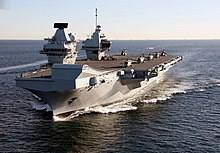
Aircraft carriers today are usually divided into the following four categories based on the way that aircraft take off and land:
- Catapult-assisted take-off barrier-arrested recovery(CATOBAR): these carriers generally carry the largest, heaviest, and most heavily armed aircraft, although smaller CATOBAR carriers may have other limitations (weight capacity of aircraft elevator, etc.). All CATOBAR carriers in service today are nuclear-powered. Twelve are in service: tenNimitzand oneGerald R. Ford-classfleet carriers in the United States; and theCharles de Gaullein France.
- Short take-off barrier-arrested recovery(STOBAR): these carriers are generally limited to carrying lighter fixed-wing aircraft with more limited payloads. STOBAR carrier air wings, such as theSukhoi Su-33and futureMikoyan MiG-29Kwings ofAdmiral Kuznetsovare often geared primarily towards air superiority and fleet defense roles rather than strike/power projection tasks,[citation needed]which require heavier payloads (bombs and air-to-ground missiles). Five are in service: two in China, two in India, and one in Russia.
- Short take-off vertical-landing(STOVL): limited to carrying STOVL aircraft. STOVL aircraft, such as theHarrierfamily andYakovlev Yak-38generally have limited payloads, lower performance, and high fuel consumption when compared with conventional fixed-wing aircraft; however, a new generation of STOVL aircraft, currently consisting of theLockheed Martin F-35B Lightning II,has much improved performance. Fourteen are in service; nine STOVL amphibious assault ships in the US; two carriers each in Italy and the UK; and one STOVL amphibious assault ship in Spain.
- Helicopter carrier:Helicopter carriers have a similar appearance to other aircraft carriers but operate only helicopters – those that mainly operate helicopters but can also operate fixed-wing aircraft are known as STOVL carriers (see above). Seventeen are in service: four in Japan; three in France; two each in Australia, China, Egypt and South Korea; and one each in Brazil and Thailand. In the past, some conventional carriers were converted and these were called "commando carriers" by the Royal Navy. Some helicopter carriers, but not all, are classified asamphibious assault ships,tasked with landing and supporting ground forces on enemy territory.
By size
[edit]Supercarrier
[edit]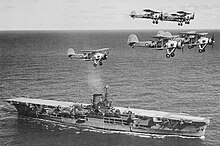
The appellation "supercarrier" is not an official designation with any national navy, but a term used predominantly by the media and typically when reporting on larger and more advanced carrier types. It is also used when comparing carriers of various sizes and capabilities, both current and past. It was first used byThe New York Timesin 1938,[9]in an article about the Royal Navy'sHMSArk Royal,that had a length of 800 feet (244 m), a displacement of 22,000tonand was designed to carry 72 aircraft.[10][11]Since then, aircraft carriers have consistently grown in size, both in length and displacement, as well as improved capabilities; in defense, sensors, electronic warfare, propulsion, range, launch and recovery systems, number and types of aircraft carried and number of sorties flown per day.
China and the United Kingdom both have carriers in service or under construction with displacements ranging from 65,000[12]to 85,000 tons[13]and lengths from 280 to 320 meters (920 to 1,050 ft)[14][15]which have been described as "supercarriers".[16][17][13]The largest "supercarriers" in service as of 2022, however, are with the US Navy,[18]with displacements exceeding 100,000 tons,[18]lengths of over 337 meters (1,106 ft),[18]and capabilities that match or exceed that of any other class.[24]
Hull type identification symbols
[edit]Several systems of identification symbol for aircraft carriers and related types of ship have been used. These include thepennant numbersused by the Royal Navy,Commonwealthcountries, and Europe, along with thehull classification symbolsused by the US andCanada.[25]
| Symbol | Designation |
|---|---|
| CV | Generic aircraft carrier |
| CVA | Attack carrier (up to 1975) |
| CVB | Large aircraft carrier (retired 1952) |
| CVAN | Nuclear-powered attack carrier |
| CVE | Escort carrier |
| CVHA | Aircraft carrier, Helicopter Assault (retired) |
| CVHE | Aircraft carrier, Helicopter, Escort (retired) |
| CVV | Aircraft Carrier (Medium)(proposed) |
| CVL | Light aircraft carrier |
| CVN | Nuclear-powered aircraft carrier |
| CVS | Anti-submarine warfare carrier |
| CVT | Training Aircraft Carrier |
| CVU | Utility carrier (retired) |
| LHA | Landing helicopter assault,a type ofamphibious assault ship |
| LHD | Landing helicopter dock,a type of amphibious assault ship |
| LPH | Landing platform helicopter,a type of amphibious assault ship |
History
[edit]Origins
[edit]
The 1903 advent of the heavier-than-air fixed-wing airplane with theWright brothers' first flight atKitty Hawk, North Carolina,was closely followed on 14 November 1910, byEugene Burton Ely's first experimental take-off of aCurtiss Pusherairplane from the deck of aUnited States Navyship, the cruiserUSSBirminghamanchored offNorfolk Navy BaseinVirginia.Two months later, on 18 January 1911, Ely landed his Curtiss Pusher airplane on a platform on thearmored cruiserUSSPennsylvaniaanchored inSan Francisco Bay.On 9 May 1912, the first take off of an airplane from a ship while underway was made by CommanderCharles Samsonflying aShort Improved S.27biplane "S.38" of theRoyal Naval Air Service(RNAS) from the deck of the Royal Navy's pre-dreadnought battleshipHMSHibernia,thus providing the first practical demonstration of the aircraft carrier for naval operations at sea.[26][27]Seaplane tendersupport ships came next, with the FrenchFoudreof 1911.
Early inWorld War I,theImperial Japanese NavyshipWakamiyaconducted the world's first successful ship-launched air raid:[28]on 6 September 1914, aFarmanaircraft launched byWakamiyaattacked theAustro-HungariancruiserSMSKaiserin Elisabethand theImperial GermangunboatJaguarinJiaozhou BayoffQingdao;neither was hit.[29]The first attack using an air-launchedtorpedooccurred on 2 August, when a torpedo was fired by Flight CommanderCharles Edmondsfrom aShort Type 184seaplane, launched from the seaplane carrierHMSBen-my-Chree.[30][31]
The first carrier-launched airstrike was theTondern raidin July 1918. SevenSopwith Camelswere launched from the battlecruiserHMSFuriouswhich had been completed as a carrier by replacing her planned forward turret with a flight deck and hangar prior to commissioning. The Camels attacked and damaged the German airbase at Tondern, Germany (modern dayTønder,Denmark), and destroyed twozeppelin airships.[32]
The first landing of an airplane on a moving ship was by Squadron CommanderEdwin Harris Dunning,when he landed hisSopwith Pupon HMSFuriousinScapa Flow,Orkneyon 2 August 1917. Landing on the forward flight deck required the pilot to approach round the ship's superstructure, a difficult and dangerous manoeuver and Dunning was later killed when his airplane was thrown overboard while attempting another landing onFurious.[33]HMSFuriouswas modified again when her rear turret was removed and another flight deck added over a second hangar for landing aircraft over the stern.[34]Her funnel and superstructure remained intact however andturbulencefrom the funnel and superstructure was severe enough that only three landing attempts were successful before further attempts were forbidden.[35]This experience prompted the development of vessels with a flush deck and produced the first large fleet ships. In 1918,HMSArgusbecame the world's first carrier capable of launching and recovering naval aircraft.[36]
As a result of theWashington Naval Treatyof 1922, which limited the construction of new heavy surface combat ships, most early aircraft carriers were conversions of ships that were laid down (or had served) as different ship types: cargo ships, cruisers, battlecruisers, or battleships. These conversions gave rise to theUSSLangleyin 1922, the USLe xing ton-classaircraft carriers (1927), JapaneseAkagiandKaga,and BritishCourageousclass(of whichFuriouswas one). Specialist carrier evolution was well underway, with several navies ordering and building warships that were purposefully designed to function as aircraft carriers by the mid-1920s. This resulted in the commissioning of ships such as the JapaneseHōshō(1922),[37]HMSHermes(1924, although laid down in 1918 beforeHōshō), andBéarn(1927). DuringWorld War II,these ships would become known asfleet carriers.[citation needed]
World War II
[edit]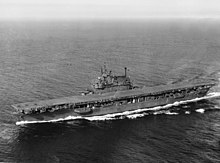
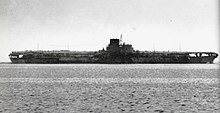
The aircraft carrier dramatically changednaval warfarein World War II, because air power was becoming a significant factor in warfare. The advent of aircraft as focal weapons was driven by the superior range, flexibility, and effectiveness of carrier-launched aircraft. They had greater range and precision than naval guns, making them highly effective. The versatility of the carrier was demonstrated in November 1940, whenHMSIllustriouslaunched a long-rangestrike on the Italian fleetat their base inTaranto,signalling the beginning of the effective and highly mobile aircraft strikes. This operation in the shallow water harbor incapacitated three of the six anchored battleships at a cost of two torpedo bombers.
World War II in the Pacific Oceaninvolved clashes between aircraft carrier fleets. The Japanese surprise attack on the American Pacific fleet atPearl Harbornaval and air bases on Sunday, 7 December 1941, was a clear illustration of the power projection capability afforded by a large force of modern carriers. Concentrating six carriers in a single unit turned naval history about, as no other nation had fielded anything comparable. In the "Doolittle Raid",on 18 April 1942, the US Navy carrierUSSHornetsailed to within 650 nautical miles (1,200 km) of Japan and launched 16B-25 Mitchellmedium bombers from her deck in a demonstrative retaliatory strike on the mainland, including the capital, Tokyo. However, the vulnerability of carriers compared to traditional capital ships was illustrated by the sinking ofHMSGloriousby German battleships during theNorwegian campaign in 1940.
This new-found importance ofnaval aviationforced nations to create a number of carriers, in efforts to provide air superiority cover for every major fleet in order to ward off enemy aircraft. This extensive usage led to the development and construction of 'light' carriers.Escort aircraft carriers,such asUSSBogue,were sometimes purpose-built but most were converted from merchant ships as a stop-gap measure to provide anti-submarine air support for convoys and amphibious invasions. Following this concept,light aircraft carriersbuilt by the US, such asUSSIndependence(commissioned in 1943), represented a larger, more "militarized" version of the escort carrier. Although with similar complement to escort carriers, they had the advantage of speed from their converted cruiser hulls. The UK1942 Design Light Fleet Carrierwas designed for building quickly by civilian shipyards and with an expected service life of about 3 years.[39]They served the Royal Navy during the war, and the hull design was chosen for nearly all aircraft carrier equipped navies after the war, until the 1980s. Emergencies also spurred the creation or conversion of highly unconventional aircraft carriers.CAM shipswere cargo-carrying merchant ships that could launch (but not retrieve) a single fighter aircraft from a catapult to defend the convoy from long range land-based German aircraft.
Postwar era
[edit]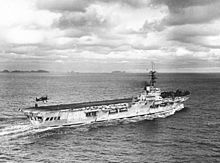
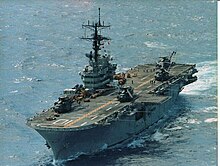

Before World War II, international naval treaties of1922,1930,and1936limited the size of capital ships including carriers. Since World War II, aircraft carrier designs have increased in size to accommodate a steady increase in aircraft size. The large, modernNimitzclassof US Navy carriers has a displacement nearly four times that of the World War II–eraUSSEnterprise,yet its complement of aircraft is roughly the same—a consequence of the steadily increasing size and weight of individual military aircraft over the years. Today's aircraft carriers are so expensive that some nations which operate them risk significant economic and military impact if a carrier is lost.[40]

Some changes were made after 1945 in carriers:
- Theangled flight deckwas invented byRoyal NavyCaptain (later Rear Admiral)Dennis Cambell,as naval aviation jets higher speeds required carriers be modified to "fit" their needs.[41][42][43]Additionally, the angled flight deck allows for simultaneous launch and recovery.
- Jet blast deflectorsbecame necessary to protect aircraft and handlers fromjet blast.The first US Navy carriers to be fitted with them were the wooden-deckedEssex-class aircraft carrierswhich were adapted to operate jets in the late 1940s. Later versions had to be water-cooled because of increasing engine power.[44]
- Optical landing systemswere developed to facilitate the very precise landing angles required by jet aircraft, which have a faster landing speed giving the pilot little time to correct misalignments, or mistakes. The first system was fitted toHMSIllustriousin 1952.[44]
- Aircraft carrier designs have increased in size to accommodate continuous increase in aircraft size. The 1950s saw US Navy's commission of "supercarriers", designed to operate naval jets, which offered better performance at the expense of bigger size and demanded more ordnance to be carried on-board (fuel, spare parts, electronics, etc.).
- The combination of increased carrier size, speed requirements above 30 knots (35 mph; 56 km/h), and a requirement to operate at sea for long periods mean that modern large aircraft carriers often use nuclear reactors to create power for propulsion, electricity, catapulting airplanes from aircraft carriers, and a few more minor uses.[45]
Modern navies that operate such aircraft carriers treat them ascapital shipsof fleets, a role previously held by the galleons, ships-of-the-line andbattleships.This change took place during World War II in response to air power becoming a significant factor in warfare, driven by the superior range, flexibility and effectiveness of carrier-launched aircraft. Following the war, carrier operations continued to increase in size and importance, and along with, carrier designs also increased in size and ability. Some of these larger carriers, dubbed by the media as "supercarriers", displacing 75,000 tons or greater, have become the pinnacle of carrier development. Some are powered bynuclear reactorsand form the core of a fleet designed to operate far from home. Amphibious assault ships, such as theWaspandMistralclasses, serve the purpose of carrying and landing Marines, and operate a large contingent of helicopters for that purpose. Also known as "commando carriers"[46]or "helicopter carriers", many have the capability to operateVSTOLaircraft.
The threatening role of aircraft carriers has a place in modernasymmetric warfare,like thegunboat diplomacyof the past.[citation needed]Carriers also facilitate quick and precise projections of overwhelming military power into such local and regional conflicts.[47]
Lacking the firepower of other warships, carriers by themselves are considered vulnerable to attack by other ships, aircraft, submarines, or missiles. Therefore, an aircraft carrier is generally accompanied by a number of other ships to provide protection for the relatively unwieldy carrier, to carry supplies, re-supply (Many carriers are self-sufficient and will supply their escorts) and perform other support services, and to provide additional offensive capabilities. The resulting group of ships is often termed acarrier strike group,battle group, carrier group, orcarrier battle group.
There is a view among some military pundits[who?]that modern anti-ship weapons systems, such as torpedoes and missiles, or even ballistic missiles with nuclear warheads have made aircraft carriers and carrier groups too vulnerable for modern combat.[48]
Carriers can also be vulnerable todiesel-electric submarines[improper synthesis?]like theGermanU24of the conventional206 classwhich in 2001 "fired" at theEnterpriseduring the exerciseJTFEX 01-2in theCaribbean Seaby firingflaresand taking a photograph through itsperiscope[49]or theSwedishGotlandwhich managed the same feat in 2006 duringJTFEX 06-2by penetrating the defensive measures ofCarrier Strike Group 7which was protectingUSSRonald Reagan.[50]
Description
[edit]Structure
[edit]Carriers are large and long ships, although there is a high degree of variation depending on their intended role andaircraft complement.The size of the carrier has varied over history and amongnavies,to cater to the various roles that global climates have demanded fromnaval aviation.
Regardless of size, the ship itself must house their complement of aircraft, with space for launching, storing, and maintaining them. Space is also required for the large crew, supplies (food, munitions, fuel, engineering parts), and propulsion. US aircraft carriers are notable for havingnuclear reactorspowering their systems and propulsion.

The top of the carrier is the flight deck, where aircraft are launched and recovered. On the starboard side of this is the island, where thefunnel,air-traffic control and thebridgeare located.
The constraints of constructing a flight deck affect the role of a given carrier strongly, as they influence the weight, type, and configuration of the aircraft that may be launched. For example, assisted launch mechanisms are used primarily for heavy aircraft, especially those loaded with air-to-ground weapons. CATOBAR is most commonly used on US Navy fleet carriers as it allows the deployment of heavy jets with full load-outs, especially on ground-attack missions. STOVL is used by other navies because it is cheaper to operate and still provides good deployment capability forfighter aircraft.
Due to the busy nature of the flight deck, only 20 or so aircraft may be on it at any one time. A hangar storage several decks below the flight deck is where most aircraft are kept, and aircraft are taken from the lower storage decks to the flight deck through the use of an elevator. The hangar is usually quite large and can take up several decks of vertical space.[51]
Munitions are commonly stored on the lower decks because they are highly explosive. Usually this is below the waterline so that the area can be flooded in case of emergency.
Flight deck
[edit]
As "runways at sea", aircraft carriers have a flat-topflight deck,whichlaunchesandrecoversaircraft. Aircraft launch forward, into the wind, and are recovered from astern. The flight deck is where the most notable differences between a carrier and a land runway are found. Creating such a surface at sea poses constraints on the carrier. For example, the size of the vessel is a fundamental limitation on runway length. This affects take-off procedure, as a shorter runway length of the deck requires that aircraftacceleratemore quickly to gain lift. This either requires a thrust boost, a vertical component to its velocity, or a reduced take-off load (to lower mass). The differing types of deck configuration, as above, influence the structure of the flight deck. The form of launch assistance a carrier provides is strongly related to the types of aircraft embarked and the design of the carrier itself.
There are two main philosophies in order to keep the deck short: add thrust to the aircraft, such as using a Catapult Assisted Take-Off (CATO-); and changing the direction of the airplanes' thrust, as in Vertical and/or Short Take-Off (V/STO-). Each method has advantages and disadvantages of its own:
- Catapult Assisted Take-Off Barrier Arrested Recovery(CATOBAR): A steam- or electric-poweredcatapultis connected to the aircraft, and is used to accelerate conventional aircraft to a safe flying speed. By the end of the catapult stroke, the aircraft is airborne and further propulsion is provided by its own engines. This is the most expensive method as it requires complex machinery to be installed under the flight deck, but allows for even heavily loaded aircraft to take off.
- Short Take-Off Barrier Arrested Recovery(STOBAR) depends on increasing the net lift on the aircraft. Aircraft do not require catapult assistance for take off; instead on nearly all ships of this type an upwards vector is provided by a ski-jump at the forward end of the flight deck, often combined with thrust vectoring by the aircraft. Alternatively, by reducing the fuel and weapon load, an aircraft is able to reach faster speeds and generate more upwards lift and launch without a ski-jump or catapult.
- Short Take-Off Vertical-Landing(STOVL): On aircraft carriers, non-catapult-assisted, fixed-wing short takeoffs are accomplished with the use ofthrust vectoring,which may also be used in conjunction with a runway "ski-jump".Use of STOVL tends to allow aircraft to carry a larger payload as compared to during VTOL use, while still only requiring a short runway. The most famous examples are theHawker Siddeley Harrierand theBAe Sea Harrier.Although technically VTOL aircraft, they are operationally STOVL aircraft due to the extra weight carried at take-off for fuel and armaments. The same is true of theLockheed F-35B Lightning II,which demonstrated VTOL capability in test flights but is operationally STOVL or in the case of UK uses "shipborne rolling vertical landing"
- Vertical Take-Off and Landing(VTOL): Certain aircraft are specifically designed for the purpose of using very high degrees of thrust vectoring (e.g. if the thrust to weight-force ratio is greater than 1, it can take off vertically), but are usually slower than conventionally propelled aircraft due to the additional weight from associated systems.
On the recovery side of the flight deck, the adaptation to the aircraft load-out is mirrored. Non-VTOL or conventional aircraft cannot decelerate on their own, and almost all carriers using them must have arrested-recovery systems (-BAR, e.g. CATOBAR or STOBAR) to recover their aircraft. Aircraft that are landing extend atailhookthat catches onarrestor wiresstretched across the deck to bring themselves to a stop in a short distance. Post-World War II Royal Navy research on safer CATOBAR recovery eventually led to universal adoption of a landing area angled off axis to allow aircraft who missed the arresting wires to "bolt" and safely return to flight for another landing attempt rather than crashing into aircraft on the forward deck.[citation needed][52]
If the aircraft are VTOL-capable or helicopters, they do not need to decelerate and hence there is no such need. The arrested-recovery system has used an angled deck since the 1950s because, in case the aircraft does not catch the arresting wire, the short deck allows easier take off by reducing the number of objects between the aircraft and the end of the runway. It also has the advantage of separating the recovery operation area from the launch area.Helicoptersand aircraft capable of vertical or short take-off and landing (V/STOL) usually recover by coming abreast of the carrier on the port side and then using their hover capability to move over the flight deck and land vertically without the need for arresting gear.
Staff and deck operations
[edit]Carriers steam at speed, up to 35knots(65 km/h; 40 mph) into the wind during flight deck operations to increase wind speed over the deck to a safe minimum. This increase in effective wind speed provides a higher launch airspeed for aircraft at the end of the catapult stroke or ski-jump, as well as making recovery safer by reducing the difference between the relative speeds of the aircraft and ship.
Since the early 1950s on conventional carriers it has been the practice to recover aircraft at an angle to port of the axial line of the ship. The primary function of this angled deck is to allow aircraft that miss the arresting wires, referred to as abolter,to become airborne again without the risk of hitting aircraft parked forward. The angled deck allows the installation of one or two "waist" catapults in addition to the two bow cats. An angled deck also improveslaunch and recovery cycleflexibility with the option of simultaneous launching and recovery of aircraft.
Conventional ( "tailhook" ) aircraft rely upon alanding signal officer(LSO, radio call sign 'paddles') to monitor the aircraft's approach, visually gauge glideslope, attitude, and airspeed, and transmit that data to the pilot. Before the angled deck emerged in the 1950s, LSOs used colored paddles to signal corrections to the pilot (hence the nickname). From the late 1950s onward, visual landing aids such as theoptical landing systemhave provided information on properglide slope,but LSOs still transmit voice calls to approaching pilots by radio.
Key personnel involved in the flight deck include the shooters, the handler, and the air Boss. Shooters arenaval aviatorsornaval flight officersand are responsible for launching aircraft. The handler works just inside the island from the flight deck and is responsible for the movement of aircraft before launching and after recovery. The "air Boss" (usually acommander) occupies the top bridge (Primary Flight Control, also calledprimaryorthe tower) and has the overall responsibility for controlling launch, recovery and "those aircraft in the air near the ship, and the movement of planes on the flight deck, which itself resembles a well-choreographed ballet".[53]The captain of the ship spends most of his time one level below primary on the Navigation Bridge. Below this is the Flag Bridge, designated for the embarked admiral and his staff.
To facilitate working on the flight deck of a US aircraft carrier, the sailors wear colored shirts that designate their responsibilities. There are at least seven different colors worn by flight deck personnel formodern United States Navy carrier air operations.Carrier operations of other nations use similar color schemes.
Deck structures
[edit]

The superstructure of a carrier (such as thebridge,flightcontrol tower) are concentrated in a relatively small area called anisland,a feature pioneered onHMSHermesin 1923. While the island is usually built on thestarboardside of the flight deck, the Japanese aircraft carriersAkagiandHiryūhad their islands built on theportside. Very few carriers have been designed or built without an island. Theflush deckconfiguration proved to have significant drawbacks, primary of which was management of the exhaust from the power plant. Fumes coming across the deck were a major issue inUSSLangley.In addition, lack of an island meant difficulties managing the flight deck, performing air traffic control, a lack of radar housing placements and problems with navigating and controlling the ship itself.[54]
Another deck structure that can be seen is aski-jump rampat the forward end of the flight deck. This was first developed to help launchshort take off vertical landing(STOVL) aircraft take off at far higher weights than is possible with a vertical or rolling takeoff on flat decks. Originally developed by the Royal Navy, it since has been adopted by many navies for smaller carriers. A ski-jump ramp works by converting some of the forward rolling movement of the aircraft into vertical velocity and is sometimes combined with the aiming of jet thrust partly downwards. This allows heavily loaded and fueled aircraft a few more precious seconds to attain sufficient air velocity and lift to sustain normal flight. Without a ski-jump, launching fully-loaded and fueled aircraft such as the Harrier would not be possible on a smaller flat deck ship before eitherstalling outor crashing directly into the sea.
Although STOVL aircraft are capable of taking off vertically from a spot on the deck, using the ramp and a running start is far more fuel efficient and permits a heavier launch weight. As catapults are unnecessary, carriers with this arrangement reduce weight, complexity, and space needed for complex steam or electromagnetic launching equipment. Vertical landing aircraft also remove the need for arresting cables and related hardware. Russian, Chinese, and Indian carriers include a ski-jump ramp for launching lightly loaded conventional fighter aircraft but recover using traditional carrier arresting cables and a tailhook on their aircraft.
The disadvantage of the ski-jump is the penalty it exacts on aircraft size, payload, and fuel load (and thus range); heavily laden aircraft cannot launch using a ski-jump because their high loaded weight requires either a longer takeoff roll than is possible on a carrier deck, or assistance from a catapult orJATOrocket. For example, the RussianSukhoi Su-33is only able to launch from the carrierAdmiral Kuznetsovwith a minimal armament and fuel load. Another disadvantage is on mixed flight deck operations where helicopters are also present, such as on a USlanding helicopter dockorlanding helicopter assaultamphibious assault ship. A ski jump is not included as this would eliminate one or more helicopter landing areas; this flat deck limits the loading of Harriers but is somewhat mitigated by the longer rolling start provided by a long flight deck compared to many STOVL carriers.
National fleets
[edit]
The US Navy has the largest fleet of carriers in the world, with eleven supercarriers currently in service. China and India each have two STOBAR carriers in service. The UK has two STOVL carriers in service. The navies of France and Russia each operate a single medium-sized carrier.[a]The US also has nine similarly sized Amphibious Warfare Ships. There are five small light carriers in use capable of operating both fixed-wing aircraft and helicopters; Japan and Italy each operate two, and Spain one.
Additionally there are eighteen small carriers which only operate helicopters serving the navies of Australia (2), Brazil (1), China (2), Egypt (2), France (3), Japan (4), South Korea (2), Thailand (1) and Turkey (1).
Algeria
[edit]- Current
Kalaat Béni Abbès(L-474) is anamphibious transport dock[55]of theAlgerian National Navywith two deck-landing spots for helicopters.
Australia
[edit]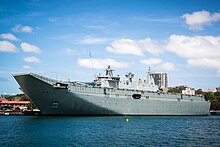
- Current
TheRoyal Australian Navyoperates twoCanberra-class landing helicopter docks.The two-ship class, based on the Spanish vesselJuan Carlos Iand built byNavantiaandBAE Systems Australia,represents the largest ships ever built for the Royal Australian Navy.[56]
HMASCanberraunderwentsea trialsin late 2013 and was commissioned in 2014. Hersister ship,HMASAdelaide,was commissioned in December 2015. The Australian ships retain the ski-ramp from theJuan Carlos Idesign, although the RAN has not acquired carrier-based fixed-wing aircraft.
Brazil
[edit]- Current
In December 2017, theBrazilian Navyconfirmed the purchase ofHMSOceanfor (GBP) £84.6 million (equivalent to R$359.5M and US$113.2M) and renamed herAtlântico.The ship was decommissioned from Royal Navy service in March 2018. TheBrazilian Navycommissioned the carrier on 29 June 2018 in the United Kingdom. After undertaking a period of maintenance in the UK, the ship travelled to its new home port,Arsenal de Marinha do Rio de Janeiro(AMRJ) in order to be fully operational by 2020.[57][58][59]The ship displaces 21,578 tonnes, is 203.43 meters (667.4 ft) long and has a range of 8,000 nautical miles (15,000 km; 9,200 mi).[60][61]
Before leavingHMNB Devonportfor her new homeport in Rio's AMRJ,Atlânticounderwent operational sea training under the Royal Navy's Flag Officer Sea Training (FOST) program.[62][63]
On 12 November 2020,Atlânticowas redesignated "NAM", for "multipurpose aircraft carrier" (Portuguese:Navio Aeródromo Multipropósito), from "PHM", for "multipurpose helicopter carrier" (Portuguese:Porta-Helicópteros Multipropósito), to reflect the ship's capability to operate with fixed-wingmedium-altitude long-endurance unmanned aerial vehiclesas well as crewedtiltrotorVTOLaircraft.[64]
China
[edit]
- Current
2STOBARcarriers:
- Liaoning(60,900 tons) was originally built as the SovietKuznetsov-classcarrierVaryag[65]and was later purchased as ahulkin 1998 on the pretext of use as a floatingcasino,then towed to China for rebuild and completion.[66]Liaoningwas commissioned on 25 September 2012 and began service for testing and training.[67]In November 2012,Liaoninglaunched and recoveredShenyang J-15naval fighter aircraft for the first time.[68][69]After a refit in January 2019, she was assigned to the North Sea Fleet, a change from her previous role as a training carrier.[70]
- Shandong(60,000–70,000 tons) was launched on 26 April 2017. She is the first to be built domestically, to an improvedKuznetsov-class design.Shandongstarted sea trials on 23 April 2018,[71]and entered service in December 2019.[72]
1 CATOBAR carrier:
- Fu gian(80,000 tons) is aCATOBARcarrier which was under construction between 2015 and 2016 before being completed in June 2022.[73]She is being fitted out as of 2022 and will commence service in 2023–2024.[74][75][76]
3 Landing helicopter docks
- AType 075 LHD,Hainanwas commissioned on 23 April 2021 at the naval base in Sanya.[77]A second ship,Guangxi,was commissioned on 26 December 2021[78]and a third ship,Anhui,was commissioned in October 2022.[79]
- Future
China has had a long-term plan to operate six large aircraft carriers with two carriers per fleet.[80]
China is planning a class of eight landing helicopter dock vessels, the Type 075 (NATO reporting nameYushen-class landing helicopter assault). This is a class ofamphibious assault shipunder construction by theHudong–Zhonghua Shipbuildingcompany.[81]The first ship was commissioned in April 2021.[77]China is also planning a modified class of the same concept, theType 076 landing helicopter dock,that will also be equipped with an electromagnetic catapult launch system.[82]
Egypt
[edit]- Current
Egypt signed a contract with French shipbuilderDCNSto buy twoMistral-classhelicopter carriers for approximately 950 million euros. The two ships were originally to be sold to Russia, but the deal was cancelled by France due to the Russian invasion of Ukraine in 2014.[83]
On 2 June 2016, Egypt received the first of two helicopter carriers acquired in October 2015, the landing helicopter dockGamal Abdel Nasser.The flag transfer ceremony took place in the presence of Egyptian and French Navies' chiefs of staff, chairman and chief executive officers of both DCNS and STX France, and senior Egyptian and French officials.[84]On 16 September 2016, DCNS delivered the second of two helicopter carriers, the landing helicopter dockAnwar El Sadatwhich also participated in a jointmilitary exercisewith the French Navy before arriving at her home port ofAlexandria.[85]
Egypt is so far the only country in Africa or the Middle East to possess a helicopter carrier.[86]
France
[edit]
- Current
TheFrench Navyoperates the 42,000-tonne nuclear-powered aircraft carrier,Charles de Gaulle.Commissioned in 2001, she is the flagship of the French Navy. The ship carries a complement ofDassault Rafale MandE-2C Hawkeyeaircraft,EC725 CaracalandAS532 Cougarhelicopters forcombat search and rescue,as well as modern electronics andAstermissiles. She is aCATOBAR-type carrier that uses two 75 m C13-3 steam catapults of a shorter version of the catapult system installed on the USNimitz-classcarriers, one catapult at the bow and one across the front of the landing area.[citation needed]In addition, the French Navy operates threeMistral-class amphibious assault ships.[87]
- Future
In October 2018, the French Ministry of Defence began an 18-month study for €40 million for the eventual future replacement of the French aircraft carrierCharles de Gaullebeyond 2030. In December 2020, President Macron announced that construction of thenext generation carrierwould begin in around 2025 with sea trials to start in about 2036. The carrier is planned to have a displacement of around 75,000 tons and to carry about 32 next-generation fighters, two to three E-2D Advanced Hawkeyes and a yet-to-be-determined number of unmanned carrier air vehicles.[88]
India
[edit]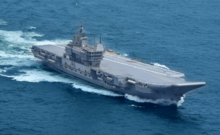
- Current
2STOBARcarriers:
INSVikramaditya,45,400 tonnes,modifiedKievclass.The carrier was purchased by India on 20 January 2004 after years of negotiations at a final price of $2.35 billion (equivalent to $3,147,000,000 in 2023). The ship successfully completed her sea trials in July 2013 and aviation trials in September 2013. She was formally commissioned on 16 November 2013 at a ceremony held at Severodvinsk, Russia.[89]
INSVikrant,also known asIndigenous Aircraft Carrier 1 (IAC-1)a 45,000-tonne, 262-metre-long (860 ft)[90]aircraft carrier whose keel was laid in 2009.[91]The new carrier will operateMiG-29Kand navalHAL Tejasaircraft.[91]The ship is powered by gas-turbines and has a range of 8,000 nautical miles (15,000 kilometres) and deploys 10 helicopters and 30 aircraft.[92]The ship was launched in 2013, sea-trials began in August 2021 and was commissioned on 02 September 2022.[93][94]
- Future
India has plans for a third carrier,INSVishal,also known asIndigenous Aircraft Carrier 2 (IAC-2)with a displacement of over 65,000 tonnes and is planned with aCATOBARsystem to launch and recover heavier aircraft.[95]
India has also issued a request for information (RFI) to procure fourLanding helicopter dockdisplacing 30,000-40,000 tons with a capacity to operate 12 medium lift special ops and two heavy lift helicopters and troops for amphibious operations.[96]
Italy
[edit]
- Current
2 STOVL carriers:
- Giuseppe Garibaldi:14,000-tonne Italian STOVL carrier, commissioned in 1985.
- Cavour:30,000-tonne Italian STOVL carrier designed and built with secondary amphibious assault facilities, commissioned in 2008.[97]
- Future
Italy plans to replace ageing aircraft carrierGiuseppe Garibaldi,as well as one of theSan Giorgio-classlanding helicopter docks, with a new amphibious assault ship, to be namedTrieste.[98][99]The ship will be significantly larger than her predecessors with a displacement of 38,000 tonnes at full load.Triesteis to carry the F-35B Joint Strike Fighter.[100][101]Meanwhile,Giuseppe Garibaldiwill be transferred toItalian Space Operation Commandfor use as a satellite launch platform.[102]
Japan
[edit]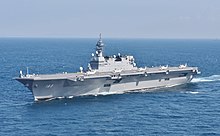
- Current
- 2Izumo-class multi-purpose destroyers– 250-metre-long (820 ft), 19,500-tonne (27,000 tonnes full load) STOVL carrierIzumowas launched August 2013 and commissioned March 2015.Izumo's sister ship,Kaga,was commissioned in 2017.
In December 2018, the Japanese Cabinet gave approval to convert bothIzumo-classdestroyers into aircraft carriers for F-35BSTOVLoperations.[103]The conversion ofIzumowas underway as of mid-2020.[104]The modification of maritime escort vessels is to "increase operational flexibility" and enhance Pacific air defense,[105][106]the Japanese defense ministry's position is "We are not creating carrier air wings or carrier air squadrons" similar to the US Navy.[citation needed]The Japanese STOVL F-35s, when delivered, will be operated by theJapan Air Self Defense Forcefrom land bases; according to the 2020 Japanese Defense Ministry white paper the STOVL model was chosen for the JASDF due the lack of appropriately long runways to support air superiority capability across all of Japanese airspace.[107][108]Japan has requested that the USMC deploy STOVL F-35s and crews aboard theIzumo-classships "for cooperation and advice on how to operate the fighter on the deck of the modified ships".[109][105] On 3 October 2021, two USMC F-35Bs performed the first vertical landings and horizontal take-offs from JSIzumo,marking 75 years since fixed-wing aircraft operated from a Japanese carrier.[110]
- 2Hyūga-class helicopter destroyers– 19,000-tonne (full load)anti-submarine warfare carrierswith enhanced command-and-control capabilities allowing them to serve as fleet flagships.
Russia
[edit]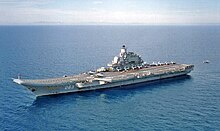
- Current
1 STOBAR carrier:Admiral Flota Sovetskogo Soyuza Kuznetsov:55,000-tonneKuznetsov-classSTOBARaircraft carrier. Launched in 1985 asTbilisi,renamed and operational from 1995. Without catapults she can launch and recover lightly fueled naval fighters for air defense or anti-ship missions but not heavy conventional bombing strikes.[citation needed]Officially designated an aircraft carrying cruiser, she is unique in carrying a heavy cruiser's complement of defensive weapons and largeP-700 Granitoffensive missiles. The P-700[111]systems will be removed in the coming refit to enlarge her below decks aviation facilities as well as upgrading her defensive systems.[112]
The ship has been out of service and in repairs since 2018. The current projection is that repairs will be completed and the ship will be transferred back to the Russian Navy sometime in 2024, however this may be pushed back to 2025 if issues arise during overhaul and testing.[113][114]
- Future
The Russian Government has been considering the potential replacement ofAdmiral Kuznetsovfor some time and has considered theShtorm-class aircraft carrieras a possible option. This carrier will be a hybrid of CATOBAR and STOBAR, given the fact that she utilizes both systems of launching aircraft. The carrier is expected to costbetween $1.8 billion and $5.63 billion.[clarification needed][115]As of 2020, the project had not yet been approved and, given the financial costs, it was unclear whether it would be made a priority over other elements of Russian naval modernization.[116]
A class of 2 LHD,Project 23900is planned and an official keel laying ceremony for the project happened on 20 July 2020.[117]
South Korea
[edit]
- Current
TwoDokdo-class18,860-tonne full deck amphibious assault ships with hospital and well deck and facilities to serve as fleet flagships.
- Future
South Korea has set tentative plans for procuring two light aircraft carriers by 2033, which would help make the ROKN a blue water navy.[118][119]In December 2020, details of South Korea's planned carrier program (CVX) were finalized. A vessel of about 40,000 tons is envisaged carrying about 20 F-35B fighters as well as future maritime attack helicopters. Service entry had been anticipated in the early 2030s.[120]The program has encountered opposition in the National Assembly. In November 2021, the National Defense Committee of the National Assembly reduced the program's requested budget of 7.2 billion KRW and to just 500 million KRW (about $400K USD), effectively putting the project on hold, at least temporarily.[121]However, on 3 December 2021 the full budget of 7.2 billion won was passed by the National Assembly.[118]Basic design work is to begin in earnest starting 2022.[122]
Spain
[edit]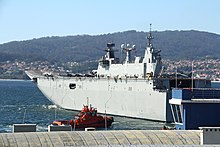
- Current
Juan Carlos I:27,000-tonne, specially designed multipurpose strategic projection ship which can operate as anamphibious assault shipand aircraft carrier. Juan Carlos I has full facilities for both functions including aski jumpforSTOVLoperations, is equipped with theAV-8B Harrier IIattack aircraft.Also,well deck,and vehicle storage area which can be used as additional hangar space, launched in 2008, commissioned 30 September 2010.[123]
Thailand
[edit]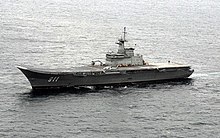
- Current
1 offshore helicopter support ship:HTMSChakri Naruebethelicopter carrier: 11,400-tonne STOVL carrier based on SpanishPríncipe de Asturiasdesign. Commissioned in 1997. The AV-8S Matador/Harrier STOVL fighter wing, mostly inoperable by 1999,[124]was retired from service without replacement in 2006.[125]As of 2010, the ship is used for helicopter operations and for disaster relief.[126]
Turkey
[edit]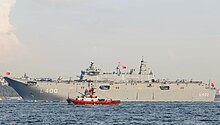
- Current
TCGAnadoluis a 27,079-tonneamphibious assault ship(LHD) of theTurkish Navythat can be configured as a 24,660-tonne V/STOL aircraft carrier.[127]Construction began on 30 April 2016 by Sedef Shipbuilding Inc. at theirIstanbulshipyard.[128][129]TCGAnadoluwas commissioned with a ceremony on 10 April 2023.[130][131][132][133][134][135][136][137][138]The construction of a sister ship, to be named TCGTrakya,is currently being planned by the Turkish Navy.[139][140]
TheSikorsky S-70B Seahawkand theBell AH-1 SuperCobraare the two main types of helicopters used on TCGAnadolu,with the occasional use ofCH-47F Chinookhelicopters of theTurkish Armyduring military exercises and operations.[141]The AH-1W Super Cobras will eventually be complemented and replaced by theTAI T929 ATAK 2.[142]
Thejet-powered,low-observableBayraktar MIUS Kızılelma[132][143][144]and theMALEBayraktar TB3[145][146][147]are twoUCAVsthat are specifically designed and manufactured byBaykar Technologiesto be used on TCGAnadolu.[148]The maiden flight ofTAI Anka-3(also part of Project MIUS), a jet-powered,flying wingtype UCAV with stealth technology, was successfully completed on 28 December 2023.[149][150][151]
- Future
On 3 January 2024, the Turkish government approved the plan for the design and construction of a larger aircraft carrier.[152]
On 15 February 2024, the Design and Projects Office of the Turkish Navy announced that it will be a STOBAR aircraft carrier with an overall length of 285 metres (935 ft), beam of 68 metres (223 ft), draught of 10.1 metres (33 ft), and displacement of 60,000 tons.[153][154][155]It will have a COGAG propulsion system and a maximum speed of 25 knots (29 mph; 46 km/h).[153][154][155]
United Kingdom
[edit]
- Current
Two 65,000-tonne[12]Queen Elizabeth-classSTOVL carriers which operate the F-35 Lightning II.HMSQueen Elizabethwas commissioned in December 2017[156]andHMSPrince of Walesin December 2019.
Queen Elizabethundertook her first operational deployment in 2021.[157]EachQueen Elizabeth-class ship is able to operate around 40 aircraft during peacetime operations and is thought to be able to carry up to 72 at maximum capacity.[158]As of the end of April 2020, 18 F-35B aircraft had been delivered to the Royal Navy and the Royal Air Force. "Full operating capability" for the UK's carrier strike capability had been planned for 2023 (two squadrons or 24 jets operating from one carrier).[159]The longer-term aim remains for the ability to conduct a wide range of air operations and support amphibious operations worldwide from both carriers by 2026.[159]They form the central part of theUK Carrier Strike Group.
- Future
TheQueen Elizabeth-class ships are expected to have service lives of 50 years.[160]
United States
[edit]
- Current
11 CATOBAR carriers, all nuclear-powered:
- Nimitzclass:ten 101,000-tonne, 333-meter-long (1,092 ft) fleet carriers, the first of which was commissioned in 1975. ANimitz-class carrier is powered by twonuclear reactorsproviding steam to foursteam turbines.
- Gerald R. Fordclass,one 100,000-tonne, 337-meter-long (1,106 ft) fleet carrier. The lead of the classGerald R. Fordcame into service in 2017, with another nine planned to replace the agingNimitz-class ships.
Nine amphibious assault ships carrying vehicles, Marine fighters, attack and transport helicopters, and landing craft with STOVL fighters for CAS and CAP:
- Americaclass:a class of 45,000-tonne amphibious assault ships, although the first two ships in this class, (Flight 0) do not have well decks, all subsequent ships (Flight I) will have well decks. Two ships are currently in service out of a planned 11 ships. Ships of this class can have a secondary mission as a light aircraft carrier with 20AV-8B Harrier II,and in the future theF-35B Lightning IIaircraft after unloading their Marine expeditionary unit.
- Waspclass:a class of 41,000-tonne amphibious assault ships, members of this class have been used in wartime in their secondary mission as light carriers with 20 to 25 AV-8Bs after unloading their Marine expeditionary unit. Seven ship currently in service of an original eight, withone lost to fire.
- Future
The current US fleet ofNimitz-class carriers will be followed into service (and in some cases replaced) by theGerald R. Fordclass.It is expected that the ships will be more automated in an effort to reduce the amount of funding required to maintain and operate the vessels. The main new features are implementation ofElectromagnetic Aircraft Launch System(EMALS) (which replaces the old steam catapults) andunmanned aerial vehicles.[161]In terms of future carrier developments, Congress has discussed the possibility of accelerating the phasing-out of one or moreNimitz-class carriers, postponing or canceling the procurement of CVN-81 and CVN-82, or modifying the purchase contract.[162]
Following the deactivation ofUSSEnterprisein December 2012, the US fleet comprised 10 fleet carriers, but that number increased back to 11 with the commissioning ofGerald R. Fordin July 2017. TheHouse Armed Services Seapower subcommitteeon 24 July 2007, recommended seven or eight new carriers (one every four years). However, the debate has deepened over budgeting for the $12–14.5 billion (plus $12 billion for development and research) for the 100,000-tonneGerald R. Ford-class carrier (estimated service 2017) compared to the smaller $2 billion 45,000-tonneAmerica-class amphibious assault ships,which are able to deploy squadrons of F-35Bs. The first of this class,USSAmerica,is now in active service with another,USSTripoli,and 9 more are planned.[163][164]
In a report to Congress in February 2018, the Navy stated it intends to maintain a "12CVNforce "as part of its 30-year acquisition plan.[165]
Aircraft carriers in preservation
[edit]Current museum carriers
[edit]A few aircraft carriers have been preserved as museum ships. They are:
- USSYorktown(CV-10)inMount Pleasant,South Carolina
- USSIntrepid(CV-11)inNew York City
- USSHornet(CV-12)inAlameda,California
- USSLe xing ton(CV-16)inCorpus Christi,Texas
- USSMidway(CV-41)inSan Diego,California
- Soviet aircraft carrierKievinTianjin,China
- Soviet aircraft carrierMinskinNantong,China
Former museum carriers
[edit]- INSVikrant(1961)was moored as a museum inMumbaifrom 2001 to 2012, but was never able to find an industrial partner and was closed that year. She was scrapped in 2014.[166]
- USSCabot(CVL-28)was acquired for preservation and moored inNew Orleansfrom 1990 to 2002, but due to an embezzlement scandal, funding for the museum never materialized and the ship was scrapped in 2002.[citation needed]
Future museum carriers
[edit]- USSTarawa(LHA-1)has a preservation campaign to bring her to theWest Coast of the United Statesas the world's first amphibious assault ship museum.[167]
See also
[edit]- Airborne aircraft carrier
- Aviation-capable naval vessels
- Carrier-based aircraft
- Drone carrier
- Lily and Clover
- Merchant aircraft carrier
- Mobile offshore base
- Project Habakkuk
- Seadrome
- Submarine aircraft carrier
- Unsinkable aircraft carrier
Related lists
[edit]- List of aircraft carriers
- List of aircraft carriers in service
- List of aircraft carriers by configuration
- List of aircraft carriers of the Second World War
- List of sunken aircraft carriers
- List of amphibious warfare ships
- List of carrier-based aircraft
- List of Canadian Navy aircraft carriers
- List of aircraft carriers of the People's Liberation Army Navy (China)
- List of current French Navy aircraft carriers
- List of German aircraft carriers
- List of aircraft carriers of the Indian Navy
- List of Italian Navy aircraft carriers
- List of aircraft carriers of the Japanese Navy
- List of aircraft carriers of Russia and the Soviet Union
- List of active Spanish aircraft carriers
- List of aircraft carriers of the Royal Navy
- List of escort carriers of the Royal Navy
- List of seaplane carriers of the Royal Navy
- List of aircraft carriers of the United States Navy
- List of aircraft carrier classes of the United States Navy
- List of escort aircraft carriers of the United States Navy
Notes
[edit]- ^Russian carrier has not been operational since 2018; it is expected to be launched again in 2024.
References
[edit]- ^"Aircraft carrier",Dictionary,Reference,archivedfrom the original on 19 February 2014,retrieved3 October2013
- ^"Aircraft Carrier",Encyclopaedia,Britannica,archivedfrom the original on 5 October 2013,retrieved3 October2013,
Subsequent design modifications produced such variations as the light carrier, equipped with large amounts of electronic gear for the detection of submarines, and thehelicopter carrier,intended for conductingamphibious assault.... Carriers with combined capabilities are classified as multipurpose carriers.
- ^Petty, Dan."Fact File: Amphibious Assault Ships – LHA/LHD/LHA(R)".U.S. Navy.Archivedfrom the original on 3 September 2009.Retrieved15 November2015.
- ^"Aircraft carriers crucial, Royal Navy chief warns".BBC News.4 July 2012.Archivedfrom the original on 25 September 2015.Retrieved15 November2015.
- ^"The slow death of the carrier air wing".jalopnik. 19 July 2017.Archivedfrom the original on 11 January 2018.Retrieved10 January2018.
- ^Drew, James (8 July 2015)."US" carrier gap "could see naval air power dip in Gulf region".flightglobal.Archivedfrom the original on 17 November 2015.Retrieved15 November2015.
- ^"Will the Aircraft Carrier Survive?".13 December 2018.Archivedfrom the original on 12 November 2019.Retrieved11 September2019.
- ^USS Guadalcanal (AVG-60/ACV-60/CVE-60/CVU-60),official page at official websitehttps:// history.navy.mil/
- ^"Reich's Cruise Ships Held Potential Plane Carriers".The New York Times.1 May 1938. p. 32.Archivedfrom the original on 24 February 2018.Retrieved17 May2015.(subscription required)
- ^"The Ark Royal Launched. Most Up-To-Date Carrier. Aircraft in the Fleet".The Times.14 April 1937. p. 11.
- ^Rossiter, Mike (2007) [2006].Ark Royal: the life, death and rediscovery of the legendary Second World War aircraft carrier(2nd ed.). London: Corgi Books. pp. 48–51.ISBN978-0-552-15369-0.OCLC81453068.
- ^ab"HMSQueen Elizabeth".royalnavy.mod.uk.Archivedfrom the original on 13 January 2018.Retrieved12 January2018.
- ^ab"China kicks off construction of new supercarrier/".thediplomat. 5 January 2018.Archivedfrom the original on 16 January 2018.Retrieved1 February2018.
- ^"Queen Elizabeth Class".Royal Navy. Archived fromthe originalon 10 August 2013.Retrieved21 August2013.
- ^"China has solid plans for four aircraft carriers by 2030, could eventually have 10".nextbigfuture. 19 February 2015.Archivedfrom the original on 30 July 2017.Retrieved1 February2018.
- ^"British super carrier HMSQueen Elizabethto deploy to the Pacific ".ukdefencejournal.org.uk. 28 June 2017.Archivedfrom the original on 2 February 2018.Retrieved1 February2018.
- ^"Russian Navy may get advanced new aircraft carrier".tass. 28 June 2017.Archivedfrom the original on 10 February 2018.Retrieved1 February2018.
- ^abc"USSGerald R. Ford(CVN-78) ".militaryfactory /. 22 July 2017.Archivedfrom the original on 24 February 2018.Retrieved1 February2018.
- ^"The world's most advanced aircraft carrier is one step closer to completion".businessinsider. 16 February 2017.Archivedfrom the original on 24 February 2018.Retrieved1 February2018.
- ^"Sneak peak at US Navy's $13B aircraft carrier".cnn. 18 July 2017.Archivedfrom the original on 20 February 2018.Retrieved1 February2018.
- ^"USSGerald R. Ford:Inside the world's most advanced aircraft carrier ".foxnews. 21 July 2017.Archivedfrom the original on 2 February 2018.Retrieved1 February2018.
- ^"USSGerald R. Fordushers in new age of technology and innovation ".navylive.dodlive.mil. 21 July 2017.Archivedfrom the original on 10 February 2018.Retrieved1 February2018.
- ^"The US Navy's new $13 billion aircraft carrier will dominate the seas".marketwatch. 9 March 2016.Archivedfrom the original on 12 February 2018.Retrieved1 February2018.
- ^[19][20][21][22][23]
- ^"AWD, Hobart, MFU or DDGH – What's in a Name?".Semaphore.Royal Australian Navy. 30 July 2010.Archivedfrom the original on 26 December 2013.Retrieved19 January2014.
- ^"The Naval Review and the Aviators".Flight.Vol. IV, no. 177. 18 May 1912. p. 442.Archivedfrom the original on 17 November 2015.Retrieved15 November2015.
- ^"Flight From the Hibernia".The Times.No. 39895. London. 10 May 1912. p. 8 (3).
- ^Polak 2005,p. 92.
- ^Donko, Wilhelm M. (2013).Österreichs Kriegsmarine in Fernost: Alle Fahrten von Schiffen der k.(u.)k. Kriegsmarine nach Ostasien, Australien und Ozeanien von 1820 bis 1914.Berlin Epubli. pp. 4, 156–162, 427.
- ^Sturtivant 1990,p. 215.
- ^269 Squadron History: 1914–1923
- ^Probert, p. 46
- ^The First World War: A Complete History by SirMartin Gilbert[1]Archived5 September 2021 at theWayback Machine
- ^Parkes, p. 622.
- ^Parkes, p. 624.
- ^Till 1996,p. 191.
- ^"Japanese inventions that changed the world".CNN.13 June 2017.Archivedfrom the original on 3 November 2017.Retrieved20 February2018.
- ^Enright & Ryan, p. xiv
- ^Robbins, Guy (2001).The Aircraft Carrier Story: 1908–1945.London: Cassel. p.91.ISBN978-0-30435-308-8.
- ^Cochran, Daniel (2018)."Will the Aircraft Carrier Survive?; Future Air Threats to the Carrier (and How to Defend It)".Joint Air Power Competence Centre (japcc.org).Archivedfrom the original on 25 July 2020.Retrieved7 June2020.
- ^"The Angled Deck Story".denniscambell.org.uk.2012. Archived fromthe originalon 4 March 2016.Retrieved9 November2015.
- ^"History of Fleet Air Arm Officers Association".FAAOA.org.2015.Archivedfrom the original on 25 February 2021.Retrieved9 November2015.
- ^Hone, Thomas C.;Friedman, Norman;Mandeles, Mark D. (2011). "Innovation in Carrier Aviation".Newport Paper 37.Naval War College Press.;abridged findings published as"The Development of the Angled-Deck Aircraft Carrier".Naval War College Review.64(2): 63–78. Spring 2011.
- ^abHobbs 2009, Chapter 14
- ^"Nuclear-Powered Ships | Nuclear Submarines".world-nuclear.org.Archivedfrom the original on 25 September 2019.Retrieved11 September2019.
- ^A number of British conversions of light fleet carriers to helicopter operations were known as commando carriers, though they did not operate landing craft
- ^Lekic, Slobodan (8 May 2011)."Navies expanding use of aircraft carriers".Navy Times.Archived fromthe originalon 17 November 2015.Retrieved15 November2015.
- ^Hendrix, Henry J.; Williams, J. Noel (May 2011)."Twilight of the $UPERfluous Carrier".Proceedings.Vol. 137. U.S. Naval Institute.Archivedfrom the original on 17 November 2015.Retrieved15 November2015.
- ^"Deutsches U-Boot fordert US-Marine heraus"(in German). t-online. 6 January 2013.Archivedfrom the original on 1 November 2020.Retrieved18 December2020.
- ^"Pentagon: New Class Of Silent Submarines Poses Threat".KNBC. 19 October 2006. Archived fromthe originalon 16 November 2007.Retrieved21 July2006.
- ^Harris, Tom (29 August 2002)."How Aircraft Carriers Work".How Stuff Works.Archivedfrom the original on 6 October 2013.
- ^"Why Aircraft Carriers Have an Angled Runway".2 November 2017.
- ^"The US Navy Aircraft Carriers".Navy.mil.Archivedfrom the original on 21 February 2009.Retrieved30 January2009.
- ^Friedman 1983,pp. 241–243.
- ^"ENHANCED SAN GIUSTO CLASS".Fincantieri.Retrieved14 November2018.
- ^Barreira, Victor (7 December 2017)."Brazil hopes to buy, commission UK's HMS Ocean by June 2018".Jane's 360.Archived fromthe originalon 13 December 2017.
- ^"O Ocean é do Brasil! MB conclui a compra do porta-helicópteros por 84 milhões de libras e dá à Força um novo capitânia – Poder Naval – A informação naval comentada e discutida".21 December 2017.Archivedfrom the original on 28 April 2018.Retrieved30 April2018.
- ^Defensa (22 December 2017)."La Marina de Brasil compra el portaviones HMSOceana la Royal Navy británica-noticia defensa ".Archivedfrom the original on 25 June 2018.Retrieved30 April2018.
- ^"PHM Atlântico: características técnicas e operacionais".naval.br(in Brazilian Portuguese). 24 August 2018.Retrieved5 August2022.
- ^"PHM A-140 Atlântico é armado com canhão Bushmaster MK.44 II de 30 mm".tecnodefesa.br(in Brazilian Portuguese). 8 July 2018.Retrieved5 August2022.
- ^Barreira, Victor (29 June 2018)."Brazil commissions helicopter carrier".Jane's.Archived fromthe originalon 22 July 2018.
- ^"Mostra de Armamento do Porta-Helicópteros Multipropósito Atlântico".Naval.29 June 2018.Archivedfrom the original on 28 April 2019.Retrieved17 July2018.
- ^"China aircraft carrier confirmed by general".BBC News.8 June 2011.Archivedfrom the original on 9 June 2011.Retrieved9 June2011.
- ^"China brings its first aircraft carrier into service, joining 9-nation club".Behind The Wall.NBC. 25 September 2012.Archivedfrom the original on 1 November 2013.Retrieved26 October2013.
- ^"China's first aircraft carrier enters service".BBC News.25 September 2012.Archivedfrom the original on 28 September 2013.Retrieved30 September2013.
- ^Axe, David (26 November 2012)."China's aircraft carrier successfully launches its first jet fighters".Wired.Archived fromthe originalon 29 November 2012.Retrieved30 September2013.
- ^"China lands first jet on its aircraft carrier".Fox News. 25 November 2012.Archivedfrom the original on 31 October 2013.Retrieved26 October2013.
- ^"Military Watch Magazine".Military watch.Archivedfrom the original on 1 December 2020.Retrieved27 September2020.
- ^"China's first home-grown Type 001A aircraft carrier begins maiden sea trial".South China Morning Post.23 April 2018.Archivedfrom the original on 29 April 2018.Retrieved29 April2018.
- ^Myers, Steven Lee (17 December 2019)."China Commissions 2nd Aircraft Carrier, Challenging US Dominance".The New York Times.Archived fromthe originalon 1 January 2022.
- ^Jack Lau (17 June 2022)."China launches Fu gian, PLA Navy's 3rd aircraft carrier".South China Morning Post.
- ^Chan, Minnie (14 February 2017)."No advanced jet launch system for China's third aircraft carrier, experts say".South China Morning Post.Archivedfrom the original on 18 April 2017.
- ^"Satellite images show how work on China's new Type 002 aircraft carrier is coming along".South China Morning Post.7 May 2019.Archivedfrom the original on 7 May 2019.Retrieved7 May2019.
- ^"Images show construction of China's third aircraft carrier, thinktank says".The Guardian.7 May 2019.Archivedfrom the original on 7 May 2019.Retrieved7 May2019.
- ^abVavasseur, Xavier (24 April 2021)."China Commissions a Type 055 DDG, a Type 075 LHD and a Type 094 SSBN in a Single Day".Naval News.Archivedfrom the original on 25 April 2021.Retrieved25 April2021.
- ^Vavasseur, Xavier (30 December 2021)."China's 2nd Type 075 LHD Guangxi Quảng Tây Commissioned With PLAN".Naval News.Archivedfrom the original on 26 February 2022.Retrieved1 January2022.
- ^Vavasseur, Xavier (1 October 2022)."China's 3rd Type 075 LHD Anhui An Huy Commissioned With PLAN".Naval News.Retrieved31 March2023.
- ^"China's Plan for 6 Aircraft Carriers Just 'Sank'".9 December 2019.Archivedfrom the original on 4 August 2020.Retrieved12 January2020.
- ^"Sea trials for Chinese Navy Type 075 LHD Landing Helicopter Dock amphibious assault ship".navyrecognition.5 August 2020.Archivedfrom the original on 9 August 2020.Retrieved25 August2020.
- ^"China planning advanced amphibious assault ship".27 July 2020.Archivedfrom the original on 23 January 2021.Retrieved8 March2021.
- ^"Egypt signs Mistral contract with France".defenceweb.co.za.12 October 2015.Archivedfrom the original on 17 November 2015.Retrieved12 October2015.
- ^"DCNS DELIVERS THE FIRST MISTRAL-CLASS HELICOPTER CARRIER TO THE EGYPTIAN NAVY, THE LHD GAMAL ABDEL NASSER".2 June 2016.Archivedfrom the original on 9 July 2016.Retrieved24 June2016.
- ^"DCNS DELIVERS THE SECOND MISTRAL-CLASS HELICOPTER CARRIER TO THE EGYPTIAN NAVY, THE LHD ANWAR EL SADAT".16 September 2016. Archived fromthe originalon 22 September 2016.Retrieved17 September2016.
- ^"Egypt is only Middle East country to own Mistral helicopter carriers".8 October 2016.Archivedfrom the original on 9 October 2016.Retrieved9 October2016.
- ^"Mistral Class – Amphibious Assault Ships – Naval Technology".Naval Technology.Archivedfrom the original on 1 January 2018.Retrieved1 January2018.
- ^"President Macron Announces Start of New French Nuclear Aircraft Carrier Program".8 December 2020.Archivedfrom the original on 24 February 2021.Retrieved13 December2020.
- ^"Aircraft carrier INS Vikramaditya inducted into Indian Navy".IBN Live.IN. Archived fromthe originalon 18 November 2013.Retrieved16 November2013.
- ^"'Historical moment': Sea trials begin for India's first indigenous aircraft carrier INS Vikrant [VIDEO] ".timesnownews.4 August 2021.Archivedfrom the original on 5 August 2021.Retrieved5 August2021.
- ^ab"Indian Aircraft Carrier (Project 71)".Indian Navy [Bharatiya Nau Sena].Bharat Rakshak. Archived fromthe originalon 17 February 2012.Retrieved11 September2009.
- ^Reporter, B. S. (11 June 2015)."Cochin Shipyard undocks INS Vikrant".Business Standard India.Archivedfrom the original on 28 August 2017.Retrieved20 February2018– via Business Standard.
- ^"Indigenous Aircraft Carrier, to be named INS Vikrant, is biggest ship made in India".thehindu. 25 June 2021. Archived fromthe originalon 28 June 2021.Retrieved31 December2022.
- ^"India's indigenous aircraft carrier and largest warship INS Vikrant joins Navy".thehindu. 2 September 2022.Retrieved31 December2022.
- ^"US-India Collaboration on Aircraft Carriers: A Good Idea?".Archivedfrom the original on 19 May 2015.
- ^"RFI for the procurement of four LPD"(PDF).Indian Navy.26 August 2021.Retrieved27 August2021.
- ^"Cavour Page".World Wide Aircraft Carriers.Free webs.Archivedfrom the original on 12 October 2014.Retrieved26 October2013.
- ^"Piano di dismissioni delle Unità Navali entro il 2025"(PDF).Archived(PDF)from the original on 16 September 2017.
- ^"Documento Programmatico Pluriennale 2017–2019"(PDF)(in Italian). Minestro della Difesa.Archived(PDF)from the original on 12 April 2019.Retrieved13 January2019.
- ^"Third Italian F-35B Goes to the Italian Air Force. And the Italian Navy Is Not Happy at All".The Aviationist.26 February 2020.Archivedfrom the original on 20 May 2020.Retrieved29 May2020.
- ^""Fulge super mare", risplende sul mare la nuova nave da assalto anfibio multiruolo costruita a Castellammare di Stabia "(Press release) (in Italian). Marina Militare. 17 August 2021.Archivedfrom the original on 29 December 2021.Retrieved15 February2022.
- ^(di Tiziano Ciocchetti)."Il Garibaldi lancerà in orbita satelliti - Difesa Online"(in Italian). Difesaonline.it. Archived fromthe originalon 24 January 2022.Retrieved10 February2022.
- ^"Japan to have first aircraft carriers since World War II".CNN. 18 December 2018.Archivedfrom the original on 18 December 2018.Retrieved18 December2018.
- ^"Japanese Izumo carrier modification progresses well".29 June 2020.Archivedfrom the original on 30 June 2020.Retrieved30 June2020.
- ^Brad Lendon and Yoko Wakatsuki (18 December 2018)."Japan to have first aircraft carriers since World War II".CNN.Archivedfrom the original on 2 October 2021.Retrieved21 July2021.
- ^"Lack of runways spurred Japan's F-35B purchase".airforce-technology.21 August 2020.Archivedfrom the original on 23 September 2020.Retrieved14 October2020.
- ^"Japan Maritime Self-Defense Force Expanding as Tokyo Takes New Approach to Maritime Security".29 May 2019.Archivedfrom the original on 26 October 2020.Retrieved14 October2020.
- ^"Marines Considering Flying U.S. F-35Bs off of Japan's Largest Warships".23 August 2019.Archivedfrom the original on 1 November 2020.Retrieved12 October2020.
- ^Brimelow, Benjamin (8 October 2021)."Japan is converting its 2 biggest warships into aircraft carriers, and US Marines are helping it train to use them".Business Insider.Retrieved20 October2021.
- ^Thakur, Vijainder K. (22 November 2023)."Russia Bids Adieu To World's 'Most Destructive' P-700 Granit; Hypersonic Zircon Missile To Take Charge".Latest Asian, Middle-East, EurAsian, Indian News.Retrieved27 June2024.
- ^"Admiral Flota Sovetskogo Soyuza Kuznetsov".Rus navy.Archivedfrom the original on 7 October 2017.Retrieved26 October2013.
- ^Alona Mazurenko (9 January 2023)."Russians brought their only aircraft carrier to critical condition and looking for those responsible".Ukrainska Pravda.Retrieved10 January2023.
- ^"Источник ТАСС допустил сдвиг сдачи" Адмирала Кузнецова "на 2025 год".flotprom.ru(in Russian). 4 July 2023.Retrieved7 July2023.
- ^"Russia developing $5 bln aircraft carrier with no world analogs—fleet commander".TASS.Archivedfrom the original on 19 March 2016.Retrieved21 March2016.
- ^"Military Watch Magazine".militarywatchmagazine.Archivedfrom the original on 25 April 2021.Retrieved13 December2020.
- ^Vavasseur, Xavier (21 July 2020)."Russia Lays Keels of Next Gen LHD, Submarines and Frigates in Presence of Russian President Putin".Naval News.Archivedfrom the original on 22 September 2020.Retrieved25 August2020.
- ^ab"국방 분야 핵심공약 좌초 우려에 정무라인 물밑작업 끝 원안 통과문대통령, 경항모 중요성 거듭 강조…예산부활 보고받고는 '반색".yna.co.kr. 3 December 2021.Archivedfrom the original on 3 December 2021.Retrieved3 December2021.
- ^"S. Korea Envisions Light Aircraft Carrier".Defense News.15 January 2014. Archived fromthe originalon 24 November 2013.Retrieved19 January2014.
- ^"South Korea Officially Starts LPX-II Aircraft Carrier Program".4 January 2021.Archivedfrom the original on 4 January 2021.Retrieved4 January2021.
- ^Lee, Daehan (16 November 2021)."South Korea's CVX Aircraft Carrier Project Faces New Budget Cuts".Naval News.Archivedfrom the original on 16 November 2021.Retrieved28 November2021.
- ^"결국 되살아난 '경항모 예산' 72억…해군, 내년 기본설계 추진".hankyung. 3 December 2021.Archivedfrom the original on 3 December 2021.Retrieved3 December2021.
- ^Head, Jeff, "BPE",World wide aircraft carriers,Free webs,archivedfrom the original on 9 April 2013,retrieved8 April2013
- ^Carpenter & Wiencek, Asian Security Handbook 2000, p. 302.
- ^Cooper., Peter (8 March 2011)."End of a Legend – Harrier Farewell".Pacificwingsmagazine.Archived fromthe originalon 14 July 2012.Retrieved26 October2013.
- ^"Thai Aircraft Carrier Assists Southern Relief Efforts | Pattaya Daily News – Pattaya Newspaper, Powerful news at your fingertips".Pattaya Daily News. 4 November 2010. Archived fromthe originalon 14 October 2013.Retrieved26 October2013.
- ^"Uçak Gemisi Olan Ülkeleri Öğrenelim".Enkucuk.23 November 2017.Archivedfrom the original on 29 January 2020.Retrieved24 April2020.
- ^Turkish Navy's flagship to enter service in 2020,Anadolu Agency, archived fromthe originalon 30 November 2019,retrieved21 November2019
- ^"[ANALYSIS] TCG Anadolu: the most powerful warship and the flagship of the Turkish Navy".turkishminute. 10 December 2022.Retrieved31 December2022.
- ^"Dünyanın ilk SİHA gemisi TCG Anadolu! Cumhurbaşkanı Erdoğan: Nihai hedefimiz tam bağımsız savunma sanayiidir".CNN Türk.10 April 2023.
- ^"Turkish Navy Officially Welcomes Its New Flagship, TCG Anadolu".TRT World.11 April 2023.
- ^abEmma Helfrich (11 April 2023)."Turkey's 'Drone Carrier' Amphibious Assault Ship Enters Service".thedrive.
- ^"Turkish Navy Commissions TCG Anadolu Amphibious Assault Ship".defenceturkey.Defence Turkey. 10 April 2023.
- ^"TCG Anadolu (L-400) at the Bosporus strait in Istanbul".TRT Haber.23 April 2023.
- ^"TCG Anadolu at the Bosporus strait in Istanbul".Anadolu Agency.23 April 2023.
- ^"TCG Anadolu at the Bosporus strait in Istanbul".haberturk.Habertürk.23 April 2023.
- ^"TCG Anadolu at the Bosporus strait in Istanbul".haberturk.Habertürk.23 April 2023.
- ^"TCG Anadolu (L-400) passing under the 1915 Çanakkale Bridge at the Dardanelles strait, with the Gallipoli peninsula in the background".kaleninsesi.2 May 2023.
- ^Anıl Şahin (14 February 2019)."Deniz Kuvvetlerinden TCG Trakya açıklaması".SavunmaSanayiST.Archivedfrom the original on 12 February 2020.Retrieved4 April2020.
- ^Ahmet Doğan (9 November 2019)."TCG Trakya ne zaman bitecek?".DenizHaber.Archivedfrom the original on 12 February 2020.Retrieved4 April2020.
- ^"TCG Anadolu eğitim gerçekleştirdi".TRT Haber.8 June 2023.
- ^Paul Iddon (24 November 2022)."TCG Anadolu: Turkey's New Flagship Will Carry Unique Aircraft".Forbes.
- ^"Baykar's unmanned fighter aircraft completes first flight".baykartech.Baykar Technologies. 15 December 2022.
- ^"Bayraktar Kızılelma's Formation Flights — A First in Aviation History".Baykar Technologies. 5 June 2023.
- ^"Bayraktar TB3".baykartech.Baykar Technologies.
- ^"Bayraktar TB3 UCAV: General Information".baykartech.Baykar Technologies.
- ^"Türkiye's new combat drone completes endurance flight test".baykartech.Baykar Technologies. 22 December 2023.
- ^Tayfun Özberk (1 May 2022)."Here Is How UAVs Will Be Recovered Aboard TCG Anadolu".navalnews.Naval News.
- ^Thomas Newdick (28 December 2023)."Turkey's ANKA-3 Flying Wing Unmanned Combat Air Vehicle Flies".thedrive.
- ^"Turkish Stealth Drone Makes Debut Flight After Years of Secrecy".Bloomberg.29 December 2023.
- ^"Turkey's ANKA III Fighter Drone Makes Debut Flight".Bloomberg Television. 29 December 2023.
- ^Kate Tringham (5 January 2024)."Turkey approves plans for aircraft carrier, additional Istanbul-class frigates".Janes.Janes.
- ^ab"Rendering and technical specifications of Turkey's new aircraft carrier".SavunmaSanayiST. 16 February 2024.
- ^ab"Rendering and technical specifications of Turkey's new aircraft carrier".SavunmaSanayiST. 16 February 2024.
- ^ab"Rendering and technical specifications of Turkey's new aircraft carrier".SavunmaSanayiST. 16 February 2024.
- ^Coughlin, Con (26 June 2017),"HMS Queen Elizabeth will help Britain retake its place among the military elite",The Telegraph,archivedfrom the original on 10 August 2018,retrieved10 August2018
- ^"HMS Queen Elizabeth Closer to Becoming Operational as Carrier Leaves for Trials".24 January 2020.Archivedfrom the original on 28 January 2020.Retrieved28 January2020.
- ^"HMS Queen Elizabeth: All You Need to Know About Britain's Aircraft Carrier".Archivedfrom the original on 6 May 2020.Retrieved23 December2019.
- ^ab"Carrier Strike – Preparing for deployment"(PDF).National Audit Office. 26 June 2020.Archived(PDF)from the original on 29 June 2020.Retrieved26 June2020.
- ^"Queen Elizabeth Class Aircraft Carriers".Babcock International (babcockinternational ).Archivedfrom the original on 7 June 2020.Retrieved7 June2020.
- ^"Aircraft Carriers – CVN".US Navy.Archivedfrom the original on 17 October 2013.Retrieved26 October2013.
- ^O'Rourke, R. (2015).Navy Ford (CVN-78) Class Aircraft Carrier Program: Background and Issues for Congress.Congressional Research Service Washington.
- ^Kreisher, Otto (October 2007)."Seven New Carriers (Maybe)".Air Force Magazine.Vol. 90, no. 10. Air Force Association. pp. 68–71.ISSN0730-6784.Archivedfrom the original on 23 April 2009.Retrieved2 October2007.
- ^"Huntington Ingalls, Newport News shipyard upbeat despite budget clouds".Daily Press.8 May 2014.Archivedfrom the original on 31 May 2014.Retrieved29 May2014.
- ^"Navy Submits 30-Year Ship Acquisition Plan".Navy. 12 February 2018.Archivedfrom the original on 14 February 2018.Retrieved14 February2018.
- ^"INS Vikrant, hero of '71 war, reduced to heap of scrap".The Indian Express.22 November 2014.Retrieved16 August2022.
- ^"USS Tarawa LHA-1 Amphibious Assault Ship US Navy Marines".seaforces.org.Retrieved23 May2022.
Bibliography
[edit]- Friedman, Norman (1983).U.S. Aircraft Carriers: An Illustrated Design History.Naval Institute Press.ISBN9780870217395.Archivedfrom the original on 25 July 2020.Retrieved23 March2020.
- Hobbs, David (2009).A Century of Carrier Aviation: The Evolution of Ships and Shipborne Aircraft.Barnsley, S Yorkshire: Seaforth Publishing.ISBN978-1783466986.Archivedfrom the original on 6 January 2022.Retrieved15 December2021.
- Polak, Christian (2005).Sabre et Pinceau: Par d'autres Français au Japon. 1872–1960(in French and Japanese). Hiroshi Ueki ( thực mộc hạo ), Philippe Pons, foreword; bút と đao ・ Nhật Bản の trung の もうひとつ の フランス (1872–1960). éd. L'Harmattan.
- Sturtivant, Ray (1990).British Naval Aviation, The Fleet Air Arm, 1917–1990.London: Arm & Armour Press.ISBN0-85368-938-5.
- Till, Geoffrey (1996). "Adopting the Aircraft Carrier: The British, Japanese, and American Case Studies". In Murray, Williamson; Millet, Allan R (eds.).Military Innovation in the Interwar Period.Cambridge University Press.
Further reading
[edit]- Ader, Clement.Military Aviation,1909, Edited and translated by Lee Kennett, Air University Press, Maxwell Air Force Base, Alabama, 2003,ISBN978-1-58566-118-3.
- Chesneau, Roger.Aircraft Carriers of the World, 1914 to the Present: An Illustrated Encyclopedia.Naval Institute Press, 1984.
- Francillon, René J,Tonkin Gulf Yacht Club US Carrier Operations off Vietnam,1988,ISBN978-0-87021-696-1.
- Friedman, Norman (1988).British Carrier Aviation: The Evolution of the Ships and Their Aircraft.Conway Maritime Press.ISBN9780870210549.Archivedfrom the original on 25 July 2020.Retrieved23 March2020.
- Hone, Thomas C.; Friedman, Norman; Mandeles, Mark D. (2011)."Innovation in Carrier Aviation".Naval War College Newport Papers(37): 1–171.Archivedfrom the original on 23 March 2020.Retrieved23 March2020.
- Melhorn, Charles M.Two-Block Fox: The Rise of the Aircraft Carrier, 1911–1929.Naval Institute Press, 1974.
- Nordeen, Lon,Air Warfare in the Missile Age,1985,ISBN978-1-58834-083-2.
- Polmar, Norman.Aircraft Carriers: A History of Carrier Aviation and its Influence on World Events, 1901–2006.(two vols.) Potomac Books, 2006.
- Trimble, William F. (1994).Admiral William A. Moffett: Architect of Naval Aviation.Smithsonian Institution Press.ISBN9781612514284.Archivedfrom the original on 25 July 2020.Retrieved23 March2020.
- Wadle, Ryan David.United States navy fleet problems and the development of carrier aviation, 1929–1933.PhD dissertation Texas A&M University, 2005.online.
External links
[edit]- "Launch & Recover (1960)"onYouTube- technical training film from the Royal Navy
